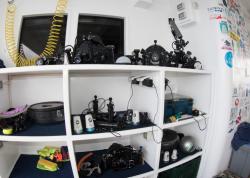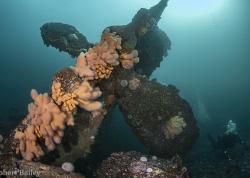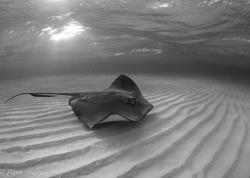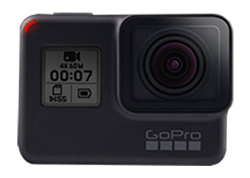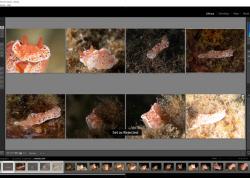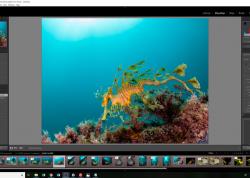Diving French Poly: Moorea, Bora Bora, and Huahine

All of my shark diving up to this point has been with skittish, aloof species like scalloped hammerheads, gray reef sharks, white tip reef sharks, black tip reef sharks, and large but seemingly mindless whale sharks. (No offense, whale sharks – I still love you). As such, I have always thought of sharks as beautiful, amazingly well-honed apex predators, but not particularly high up on the “personality” ladder. Don’t get me wrong, I absolutely love sharks, but the ones I had seen were not winning any personality contests when compared to marine mammals, octopi, turtles, or cuttlefish. Not to say they were down at the bottom either, with the nudibranchs, jellyfish, crabs, and goldfish…but I would definitely put them in the bottom half.
Moorea
With my first dive in Moorea, I learned that there are, in fact, some sharks which are quite high on the personality ladder! I learned this courtesy of Neunoeil, a 3 m long lemon shark who is older than me by a year (she was born in 1984), and according to Moorea Blue Diving’s info on its resident lemon sharks, she is the “oldest resident alpha female, caring and affectionate.”
Throughout the dive, she followed us around like a very curious and friendly puppy dog, circling in for a closer look, then swimming off into the blue… but always coming back after a few minutes. Every time she came by, I hurriedly got my camera ready for the shot. But although she was nice, much to my disappointment she did not come right up to my dome port. It was still a lot of fun watching her swim by.
Part of her charm, and photogenic appeal, is that she is always smiling. That part comes down to her lemon shark physiology; her teeth are so large that she can’t actually close her mouth! That must make things a little awkward at shark parties. You know, like when you’re at a party with someone who can’t stop smiling…that gets awkward after a while, right?
This was my first time diving with a shark with real personality, and it was phenomenal. There was no food in the water to attract her, but she just wanted to check us out and hang out with us.

The shop’s schedule for a typical morning 2-tank dive is one dive with the resident lemon sharks, and one with lots of turtles. Soon enough we started looking for turtles, and saw some nice ones hanging out in the coral. Shooting with a fisheye, there’s always the desire to get closer, but once they start making any kind of movement, I know that I’m too close and back off. So I couldn’t get right up to this guy, but it was still a decent shot.

There were also large clumps of fire coral, part of Moorea’s healthy coral ecosystem – watch out!

When Life Gives you Lemons…
For our second dive, the dive guide dropped a barrel in the water with a tuna head inside. The point was to attract lemon sharks with the scent, but not to feed them. And attract them it did, as we quickly came upon three sharks circling the barrel. Once we settled down on the bottom and stopped moving, they came fairly close to check us out, but mostly just kept circling and circling the barrel. I think it is fair to say they are also one of the most focused shark species. Nothing was distracting them from that barrel.
On this dive we had Neunoiel and two non-resident sharks hanging out with us.

The next day our first dive was with lemon sharks, and this time there were a whopping 10 (!) large lemon sharks in the vicinity of the barrel. Neunoeil, Tampax, Stallone and 7 non-residents. It’s too bad they don’t wear name tags, as their distinguishing features are hard for the untrained eye to pick out. However, our guides were very sure about who had been at the party, and showed us afterwards in their illustrated book.
As we crouched down in the sand between the corals, watching the sharks circling, I set up my strobes and camera for an upwards shot of a very close lemon shark (2-3 ft away). This meant increasing the shutter speed to avoid blowing out the surface of the water, and keeping the strobe power fairly low so as not to blow out the white undersides of the sharks.
This was the shot that I planned before we even got into the water, my Playing to Win Shot which I thought I had a decent chance of getting.
Playing to Win Shot: The ideal “competition winning” shot that you envision for the specific dive conditions, subject and background you are shooting. You can read more about this mindset here.
Although they are very large sharks, and they did come over to check me out, they were not coming close enough for me to get my playing to win shot. But that is the nature of shooting with a playing to win mindset – almost all of the time, you won’t get that perfect shot that you really want. But it will help you get the best shot you can, especially if using it in conjunction with a good Continuous Improvement Mindset. And most importantly, if the stars align and everything comes together to give you the split-second opportunity to take that winning shot, you will be ready!
As usual, there was temptation to stray from my playing to win setup. There were lots of large lemon sharks nearby. And if I only turned up my strobe power and dropped my shutter speed, I could get some head-on shots of them circling the barrel. But I decided to wait for my opportunity. So I waited, and I waited, and I waited. Nothing. And the sharks kept circling. Then our great dive guide came up and got me very nice and close, and two of the circling sharks started coming straight towards me, at a great upwards angle. But alas they turned, still maybe 2-3 feet too far away for my winning shot. It was still a nice shot, and one that I would have messed up if I had changed my settings to shoot from further away.

After spending some time enjoying the circling sharks, we headed off to look for nurse sharks (none to be found, shucks), and then returned to the barrel. I kept my settings as I had the first time, and then we had our best encounter, with Tampax. She swam right between Lisa and me, allowing for a very nice shot. Good thing, again, that I had stuck to my Playing to Win settings!

Turtle Mania
Later that day we went to Coral Wall, a site known for having tons and tons of turtles. The guide told me that on a bad day they would see a few, while on his best day they had seen 15. 15 turtles on one dive!
I lost count of how many we saw on our dive, but I know it was at least 6. They were all sitting in the coral, nice and docile. Most of my experience with turtles has been when they are swimming. But the really neat thing about when they lie in the coral is that it allows for some very different compositions. The first was a bird’s eye view – I guess this makes it a bird’s eye fisheye turtle shot. What I love about this shot is that it brings out the amazing patterns of this green turtle’s shell – something which often gets lost in the mad scramble to photograph the photogenic “old man turtle face.”

The second was a “turtle’s eye” (right?) view of the turtle sitting in the coral, right at eye level. I love the effect of getting the fisheye lens so close to the turtle’s head, and how that lets me take advantage of the distortion of the fisheye lens to add a feeling of depth to the photo.

What a great day of diving…10 lemon sharks, 6 turtles and some very high quality, close-up encounters. Certainly nothing to complain about there.
Dive Logistics
Diving with Moorea Blue Diving was fantastic. The dive guides knew their stuff and were very friendly. The rental gear was top notch and communication with the shop was excellent. We were staying in Tahiti, and each morning we took the 35 minute ferry ride from downtown Papeete to Moorea. From the Moore ferry terminal, the owner picked us up to take us to the shop, and then dropped us back at the terminal when we were done. It would make more sense to stay in Moorea to dive there, but it still works fine from Tahiti if you don’t have time (for us, we decided too last minute to get good accommodations).
Bonus Activity - Lagoonarium
Another interesting attraction in Moorea was the Lagoonarium, a great snorkeling setup with small huts and a course of underwater ropes out on a small motu (island) 5 minutes by boat from Moorea. There they did feedings to attract large amounts of blacktip sharks, stingrays, and all kinds of fish. It’s a lot of fun to do for half a day, but I would prioritize the diving over doing this activity if time is limited.

Final Thoughts on Moorea
As we had not had any good turtle or lemon shark experiences diving elsewhere in French Polynesia, this was the perfect complement to our experiences in Fakarava and Bora Bora. If you are already on Moorea, for example for the humpback trip, I think it’s a no-brainer to at least do one or two days with the lemon sharks and turtles. If you are going somewhere else, like Fakarava or Rangiroa, then it would be easy to add a day or two. The lemon sharks and turtles are a very nice complement to all the reef sharks and fish in Fakarava. And if you wanted to do more diving in Moorea, the conditions are great for beginners, and there are other dive site options so you don’t get bored.
Bora Bora
We did a total of five dives on Bora Bora. Yes, Bora Bora of the crazily expensive overwater bungalow fame. But instead of spending lots of money on luxury accommodations, we rented an AirBnB in town for less than $100/night and used the money we saved to get in the water a lot!
Inside the reef, the visibility was decent but not amazing, and there were mantas everywhere. At one point we had three swim past us. I think we probably saw 7 or more over the course of a dive, though it’s hard to tell if there were any repeats. And we learned a very valuable lesson from our dive guide – the way to have the best manta encounters was to drop down to the bottom or onto the reef (being careful not to damage anything) as soon as you saw them, and then wait. It turns out that mantas are actually really curious, and if you stay against the bottom and stay calm, they will often come over and check you out!
That was very interesting, as when I dove with mantas in the Galapagos, it was a bit of a free-for-all where everyone scrambled to get into the path of the manta to get the best shot. But this sitting down nicely and calmly and waiting was a whole different, and much better experience.
So while clinging close to the reef, I watched mantas circling around a few metres away – close enough to enjoy, but not close enough for a good photo. I kept my settings dialed in for my Playing to Win Shot - a manta within about 3 feet of me, just in case.
All of a sudden, one came right towards me. I could see right down it’s massive, gill-filled mouth. And my strobes lit it up very nicely, because they were set for exactly this type of encounter.

Then it turned and looked me over as it swam past. I have had close manta encounters before, but never the eye contact, the feeling of having one look me right in the eye. Seriously awesome.

After the encounter with this curious manta, I have decided to move mantas a few steps up the personality ladder.
Dive Logistics
We went with Eleuthera Bora Dive Center, who were excellent. The dive guides were great, the rental gear quite nice, and the communication easy and smooth. They picked us up from our place before the dives and then dropped us off afterwards. We did two morning 2-tank dives and one afternoon dive. The morning dives tend to have one dive inside the lagoon, to dive with mantas, followed by one dive on the reef outside the lagoon, for sharks.
Bora Bora has a lot of luxury resorts, which are all located on the outlying motu islands, across the lagoon from the main island. If that’s your thing, go for it, but they are not particularly budget friendly. We got a very affordable AirBnB, which was basic but certainly adequate accommodation, about a 15 minute walk from the main town of Vaitape. As mentioned, it was less than $100/night. But bring some earplugs, as there are a lot of noisy roosters around!
Final Thoughts
Bora Bora provides great opportunities to see mantas and eagle rays in the lagoon, up close, though with potentially difficult visibility (mantas) or current (eagle rays) conditions. The diving on the ocean side was not terrible, but it was also not nearly as good as Moorea or Fakarava (or Rangiroa, from what we heard). Overall, it was fun, and a worthwhile stop for the mantas, but other than that there are better diving options in French Polynesia.
Huahine
We didn’t really do Huahine justice for diving, as we only did a couple of easy dives. But we did have some other very cool underwater photography experiences. And we absolutely loved the laid-back, non-touristy vibe of the island.
We did a morning tour called the “Natural Aquarium”, with Huahine Nautique. This was basically a snorkeling tour in a shallow area, surrounded by convenient ropes, where an old local fed the resident black-tip sharks and other reef fish. There were a ton of blacktip sharks, and although they came right up to Lisa’s GoPro (thanks, SeaLife Aquapod), they were more wary of my camera and kept their distance. So I didn’t get great shots of the action, but we did see a lot of blacktip sharks, and we did get some very nice video.

After having issues getting blacktip sharks to “pop” when shooting them just in ambient light in Moorea, I decided to bring my strobes, and I think they helped me get a stronger shot here. Without them, the sharks would have blended into the background more.
Sacred Blue-Eyed Eels of Faie
What exactly does that gobbledygook mean? Well, it's only the name of one of the most charismatic and amazing underwater animals that you have never heard of. There is a river in the small town of Faie with a large population of very large blue-eyed eels, which are very friendly and not at all shy. As soon as you step into the water, they come right for you. We visited a total of three times, partly because they were a lot of fun, and partly to get the photos I was looking for.
The first time, I tried to use my strobes. Big mistake, as the brown water and very non-photogenic concrete and rock substrate impeded good photos.The next couple of times, I just shot ambient light. The river was too shallow to immerse into, so had to shoot everything blind.

This was another good example of using the Continuous Improvement mindset – shooting a location, checking the results, tweaking, iterating, and improving, and then trying again. And then again. It was only on the third visit that I got my best shot, below.

Actually, if I’d had more time I might have gone back once more if there was a day with particularly strong sunlight, to try to get more shots with cool light beams in them.

Want help booking your French Polynesia dive trip? Visit the Bluewater Dive Travel website, or drop them a line at info@bluewaterdivetravel.com!
Bonus Video
Check out our short video to get a bit better of a feel for the lemon sharks, mantas, crazy black-tip chaos, island scenery, and, saving the best for last, the incredibly charismatic blue-eyed eels!
Gear Links
- Olympus OM-D E-M1 Mark II
- Nauticam OM-D E-M1 Mark II Housing
- Sea & Sea YS-D2J strobes
- Olympus 8mm f/1.8 PRO fisheye lens
- Light & Motion Sola Photo 1200 focus light
Additional Reading
RECOMMENDED ARTICLES
SUPPORT THE UNDERWATER PHOTOGRAPHY GUIDE:
The Best Service & Prices on u/w Photo Gear
 Visit Bluewater Photo & Video for all your underwater photography and video gear. Click, or call the team at (310) 633-5052 for expert advice!
Visit Bluewater Photo & Video for all your underwater photography and video gear. Click, or call the team at (310) 633-5052 for expert advice!
The Best Pricing, Service & Expert Advice to Book your Dive Trips
 Bluewater Travel is your full-service scuba travel agency. Let our expert advisers plan and book your next dive vacation. Run by divers, for divers.
Bluewater Travel is your full-service scuba travel agency. Let our expert advisers plan and book your next dive vacation. Run by divers, for divers.




